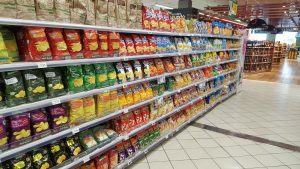In our stores, as in life, timing is everything. The saying goes that there’s a time and place for everything. This is especially true when it comes to cross-selling products and experiences for our visitors. If you want to be successful at cross-selling, you need to understand the correlation matrix of your stores and how to use it to your advantage. We recommend you review our previous articles explaining the basics of the correlation matrix and products correlations and in-store targeting activities
In this article, we will discuss the utility of time in the correlation matrix and how you can use it to maximize your cross-selling practices and raise your average basket items and sales per trip.
Utility of Time in the Correlation Matrix
A correlation matrix is a powerful tool for understanding relationships between different variables and in this case, the relationship between the categories visited in our stores. In brick-and-mortars, it can be used to identify opportunities for cross-selling products and optimize the location of our secondary touchpoints. The time variable is an important part of the correlation matrix. It can help you to understand how different stops interact over time and to identify trends that may be useful for your store. Differentiating the order in which the categories are visited influences the experience of our visitors and ultimately our stores’ performance.
When looking at the correlation matrix, you should pay special attention to the time variable. You can use this input to identify trends in your data. If you see a correlation that is trending upwards between two categories, it means that the two areas are becoming more correlated over time and therefore connected during the customer’s journey. This could be a sign of an opportunity for cross-selling products and services.
Conversely, if you see a correlation that is trending downwards, it means that the two categories are becoming less correlated over time. This could be a sign of a declining opportunity for cross-selling.
Time-based Correlation Matrix
However, there is a different way we can introduce time in our correlation matrix. We can also embed time during the correlation matrix calculation. In this case, time will tell us in which order are the sections visited and calculate the correlation between categories accordingly. A high correlation between two categories in this time-based correlation matrix will explain that these regions are very well connected in this specific order during the visit.
Using Time to Maximise Cross-Selling Practices
When it comes to cross-sell, timing may play a key role. You need to understand the correlation matrix and how to use it to your advantage. In particular, you need to pay attention to the time variable.
By understanding how this value changes throughout the visit, you can better identify opportunities for cross-selling products and services. The following figure contains examples of correlation values at different moments of the visit from the entrance to the checkouts.
Green/yellow categories represent strong/fine correlations between the selected section and other areas while orange/red represents mild/low correlation among them. This is a very applicable way to look at those points of no return to a certain category or area.
We can easily spot that as our customers pass through the different categories, the opportunities for our customers to return back to previous aisles are lower.
Introducing the time here means we can ask ourselves what is the probability of someone stopping by fruits before canned foods. Also, on the contrary, what is the probability of someone stopping by producing after frozen meat. That means we can take advantage of the time to make sure our shoppers are offered products in an optional way during their visit.
Adding Time to Your Correlation Matrix
If you want to maximize your cross-selling practices, the time variable to your correlation matrix could bring new opportunities. This will help you to understand how the different sections interact over visit time and identify trends that may be useful for your in-store campaigns. The time variable is an important part of the correlation matrix and should not be overlooked!
Adding the time variable to your correlation matrix is important for a few reasons. Here’s the list:
How to Boost Your Cross-Selling Strategies with Time
Now that you understand the importance of adding time to your correlation matrix, let’s take a look at how you can boost your cross-selling strategies with this information. Here are five tips:
Tip #01: Use time-based Correlation Matrix analysis to identify opportunities
Increase our cross-selling rates in the store finding the right place and time for new offers during the purchase path
Tip #02: Understand the dynamics of your shoppers
Offer the right product/promotion at the right time and context (e.g., present a new white wine promotion after visiting the fresh fish category. That means, anticipating our customers’ needs.
Tip #03: Optimize your endcaps and promotion gondolas
Choose the right product for each end cap to avoid bad customers experiences (e.g., offering pet food right after they visited the meat category).
Tip #04: Identify your best secondary touchpoints
Determine the optimal location for secondary touchpoints such as fridges for cold beverages to increase their conversion taking into account their previous stops.
Tip #05: Take advantage of your escape areas
Locate the escape areas. These spots in the store where, by probability, will be the last stop of the customers before going to the checkouts and take advantage of them to offer last-minute impulsive products related to their visit.
Conclusion
In conclusion, adding the time variable to your correlation matrix is an important step in improving your cross-selling strategies for your stores’ performance. By using time analysis, understanding the dynamics of your business, and identifying correlation patterns, you can make better strategic and operational decisions in-store and boost your average ticket sales and customers satisfaction levels.





